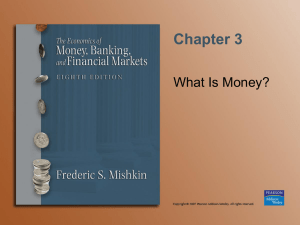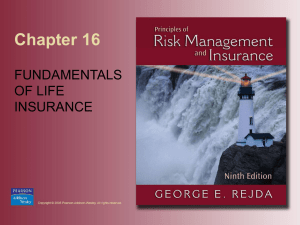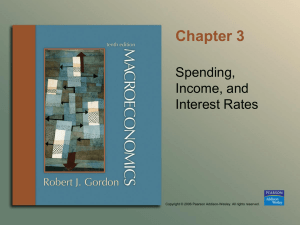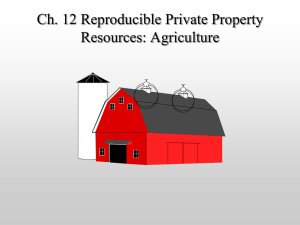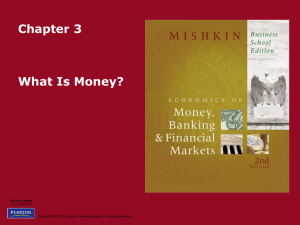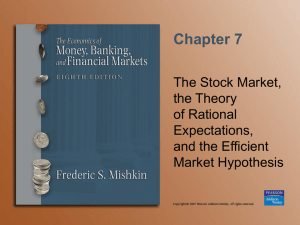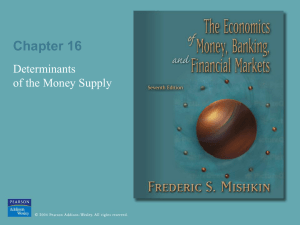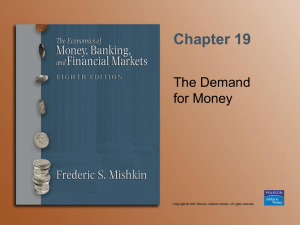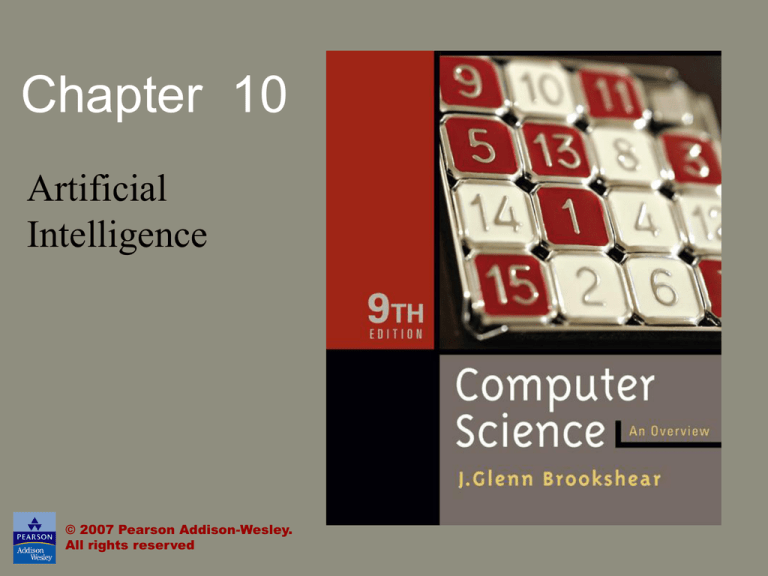
Chapter 10
Artificial
Intelligence
© 2007 Pearson Addison-Wesley.
All rights reserved
Chapter 10: Artificial Intelligence
•
•
•
•
•
•
•
10.1 Intelligence and Machines
10.2 Perception
10.3 Reasoning
10.4 Additional Areas of Research
10.5 Artificial Neural Networks
10.6 Robotics
10.7 Considering the Consequences
© 2007 Pearson Addison-Wesley. All rights reserved
0-2
Intelligent Agents
• Agent: A “device” that responds to stimuli from
its environment
– Sensors
– Actuators
• The goal of artificial intelligence is to build
agents that behave intelligently
© 2007 Pearson Addison-Wesley. All rights reserved
0-3
Levels of Intelligent Behavior
• Reflex: actions are predetermined responses to
the input data
• Intelligent response: actions affected by
knowledge of the environment
• Goal seeking
• Learning
© 2007 Pearson Addison-Wesley. All rights reserved
0-4
Figure 10.1 The eight-puzzle in
its solved configuration
© 2007 Pearson Addison-Wesley. All rights reserved
0-5
Figure 10.2 Our puzzle-solving
machine
© 2007 Pearson Addison-Wesley. All rights reserved
0-6
Approaches to Research in
Artificial Intelligence
• Performance oriented: Researcher tries to
maximize the performance of the agents.
• Simulation oriented: Researcher tries to
understand how the agents produce responses.
© 2007 Pearson Addison-Wesley. All rights reserved
0-7
Turing Test
• Proposed by Alan Turing in 1950
• Benchmark for progress in artificial intelligence
• Test setup: Human interrogator communicates
with test subject by typewriter.
• Test: Can the human interrogator distinguish
whether the test subject is human or machine?
© 2007 Pearson Addison-Wesley. All rights reserved
0-8
Techniques for Understanding
Images
• Template matching
• Image processing
– edge enhancement
– region finding
– smoothing
• Image analysis
© 2007 Pearson Addison-Wesley. All rights reserved
0-9
Language Processing
• Syntactic Analysis
• Semantic Analysis
• Contextual Analysis
© 2007 Pearson Addison-Wesley. All rights reserved
0-10
Figure 10.3 A semantic net
© 2007 Pearson Addison-Wesley. All rights reserved
0-11
Components of a Production
Systems
1. Collection of states
– Start (or initial) state
– Goal state (or states)
2. Collection of productions: rules or moves
– Each production may have preconditions
3. Control system: decides which production to
apply next
© 2007 Pearson Addison-Wesley. All rights reserved
0-12
Reasoning by Searching
• State Graph: All states and productions
• Search Tree: A record of state transitions
explored while searching for a goal state
– Breadth-first search
– Depth-first search
© 2007 Pearson Addison-Wesley. All rights reserved
0-13
Figure 10.4 A small portion of the
eight-puzzle’s state graph
© 2007 Pearson Addison-Wesley. All rights reserved
0-14
Figure 10.5 Deductive reasoning in
the context of a production system
© 2007 Pearson Addison-Wesley. All rights reserved
0-15
Figure 10.6 An unsolved
eight-puzzle
© 2007 Pearson Addison-Wesley. All rights reserved
0-16
Figure 10.7 A sample search tree
© 2007 Pearson Addison-Wesley. All rights reserved
0-17
Figure 10.8 Productions stacked
for later execution
© 2007 Pearson Addison-Wesley. All rights reserved
0-18
Heuristic Strategies
• Heuristic: A quantitative estimate of the
distance to a goal
• Requirements for good heuristics
– Must be much easier to compute than a complete
solution
– Must provide a reasonable estimate of proximity to
a goal
© 2007 Pearson Addison-Wesley. All rights reserved
0-19
Figure 10.9 An unsolved
eight-puzzle
© 2007 Pearson Addison-Wesley. All rights reserved
0-20
Figure 10.10 An algorithm for a
control system using heuristics
© 2007 Pearson Addison-Wesley. All rights reserved
0-21
Figure 10.11 The beginnings of
our heuristic search
© 2007 Pearson Addison-Wesley. All rights reserved
0-22
Figure 10.12 The search tree
after two passes
© 2007 Pearson Addison-Wesley. All rights reserved
0-23
Figure 10.13 The search tree
after three passes
© 2007 Pearson Addison-Wesley. All rights reserved
0-24
Figure 10.14
The complete
search tree
formed by our
heuristic system
Handling Real-World Knowledge
• Representation and storage
• Accessing relevant information
– Meta-Reasoning
– Closed-World Assumption
• Frame problem
© 2007 Pearson Addison-Wesley. All rights reserved
0-26
Learning
•
•
•
•
Imitation
Supervised Training
Reinforcement
Evolutionary Techniques
© 2007 Pearson Addison-Wesley. All rights reserved
0-27
Artificial Neural Networks
• Artificial Neuron
– Each input is multiplied by a weighting factor.
– Output is 1 if sum of weighted inputs exceeds the
threshold value; 0 otherwise.
• Network is programmed by adjusting weights
using feedback from examples.
© 2007 Pearson Addison-Wesley. All rights reserved
0-28
Figure 10.15 A neuron in a living
biological system
© 2007 Pearson Addison-Wesley. All rights reserved
0-29
Figure 10.16 The activities within
a processing unit
© 2007 Pearson Addison-Wesley. All rights reserved
0-30
Figure 10.17 Representation of a
processing unit
© 2007 Pearson Addison-Wesley. All rights reserved
0-31
Figure 10.18 A neural network
with two different programs
© 2007 Pearson Addison-Wesley. All rights reserved
0-32
Figure 10.19 An artificial neural
network
© 2007 Pearson Addison-Wesley. All rights reserved
0-33
Figure 10.20 Training an artificial
neural network
© 2007 Pearson Addison-Wesley. All rights reserved
0-34
Figure 10.20 Training an artificial
neural network (continued)
© 2007 Pearson Addison-Wesley. All rights reserved
0-35
Figure 10.20 Training an artificial
neural network (continued)
© 2007 Pearson Addison-Wesley. All rights reserved
0-36
Figure 10.20 Training an artificial
neural network (continued)
© 2007 Pearson Addison-Wesley. All rights reserved
0-37
Figure 10.21 The structure of
ALVINN
© 2007 Pearson Addison-Wesley. All rights reserved
0-38
Associative Memory
• Associative memory: The retrieval of
information relevant to the information at hand
• One direction of research seeks to build
associative memory using neural networks that
when given a partial pattern, transition
themselves to a completed pattern.
© 2007 Pearson Addison-Wesley. All rights reserved
0-39
Figure 10.22 An artificial neural
network implementing an
associative memory
© 2007 Pearson Addison-Wesley. All rights reserved
0-40
Figure 10.23 The steps leading to
a stable configuration
© 2007 Pearson Addison-Wesley. All rights reserved
0-41
Robotics
• Truly autonomous robots require progress in
perception and reasoning.
• Major advances being made in mobility
• Plan development versus reactive responses
• Evolutionary robotics
© 2007 Pearson Addison-Wesley. All rights reserved
0-42
Issues Raised by Artificial
Intelligence
• When should a computer’s decision be trusted
over a human’s?
• If a computer can do a job better than a human,
when should a human do the job anyway?
• What would be the social impact if computer
“intelligence” surpasses that of many humans?
© 2007 Pearson Addison-Wesley. All rights reserved
0-43

